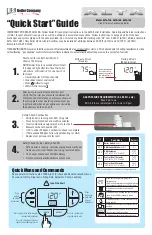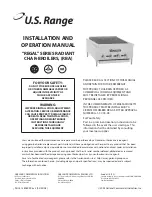
IBC Technologies Inc.
27
VFC 15-150 and VFC 45-225
2.5.6 - Error Mode
The controller continually checks
sensors to see that they are operating
within normal parameters. If sensors
indicate the boiler is operating outside it
limits, it will declare an error condition.
2 types of error conditions can occur:
Soft Errors
result when an abnormal
condition exists which does not present
an immediate safety hazard. The boiler
enters an extended purge, followed by
the error cycle of 5 minutes for all
conditions other than Maximum Ignition
Trials (which locks out for 1 hour after
3 unsuccessful ignition attempts).
Following the purge, the fan and pump
are stopped until the end of the error
cycle. Normal operation then resumes.
Hard Errors
result when a condition
exists that may be a safety hazard. The
boiler enters an extended purge then the
fan and pump are stopped. The boiler is
in a lockout, and must be checked and
restarted by a service technician.
See Section 4.3.3
Troubleshooting With
The Control Module
for a list of hard
and soft errors and their likely causes.
Note that other problems such as
disconnected wires or defective sensors
may be the cause of the error. Always
check connections and wiring first.
2.6 OTHER
OPERATING
FEATURES
2.6.1 Prioritization
The control module hosts a scheduling
routine to manage the boiler's operation
when more than one load has been
defined. Typically, loads declared as
DHW receive significant - but not
absolute - priority. A time and load-
based voting system will allocate heat
amongst
each
of up to 3 loads over time.
Multiple heating loads - with varying
temperature targets - are run
sequentially as opposed to
simultaneously (with a mixing valve).
The objective is to serve each load at the
minimum possible temperature, as
opposed to running hot then mixing
down – with hardware, saving the
related hardware and fuel cost. The
approach optimizes the low temperature
combustion benefits of direct cool
running of a radiant floor. The large
throttle turndown range coupled with
outdoor reset means that several loads
can receive heat in-turn, with less on/off
duty cycling than would occur with
other heat sources.
The boiler is shipped with default values
for each type of declarable load (e.g.
DHW, radiant floor). The preset
variables for DHW (a value of 80 on a
20-99 scale) give it substantial priority,
which declines over time if another load
is calling. Spacing heating loads (with
Outdoor Reset) are given a default value
of 35, while other SetPoint loads start
with 50 points. Over time, such points
are transferred between the loads in
accordance with the system rules. The
boiler will automatically shift between
loads once the points totals reach an
upset value. Upon a load transfer, the
burner will modulate down to its base
level and will then throttle up as
required for the new load. If competing
loads have not been satisfied at the load
switch stage, the control will register the
firing rate and will return rapidly to
such rate on the next rotation.
Heat-apportioning can be altered using
the keypad in the password protected
Installer
input section. For instance if
Baseboards (set up with Outdoor Reset
as Load 3) are not providing the desired
heat, the on-time of the baseboards can
be increased by increasing the
















































